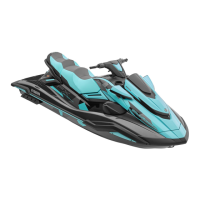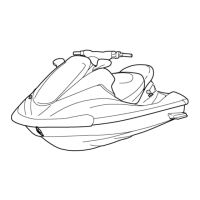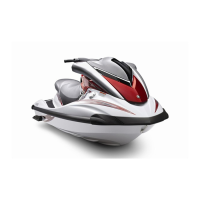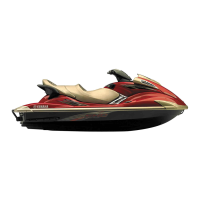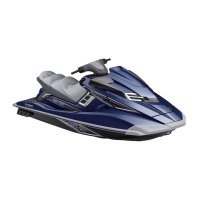Do you have a question about the Yamaha WaveRunner FX HO 2017 and is the answer not in the manual?
Details the watercraft's compliance with EU directives for personal watercraft.
Explains the meaning of WARNING, NOTICE, and TIP symbols used throughout the manual.
Details on locating and recording PRI-ID, CIN, and engine serial numbers.
Information on manufactured date, model details, builder's plate, and design category.
Highlights key labels that require attention before using the watercraft.
Identification of additional labels found on the watercraft.
Guidelines on age, experience, and load limits for operating the watercraft.
Rules for safe riding, hazard avoidance, and watercraft characteristics.
Details on required safety gear and recommended equipment for operation.
Safety considerations for wakeboarding, water-skiing, and responsible water use.
Definitions of common watercraft terms and systems.
Diagrams identifying exterior and interior parts of the watercraft.
Identification of key components located within the engine compartment.
Overview of primary controls for operating the watercraft.
Operation of the remote transmitter for security and mode settings.
Instructions for using the engine stop, shut-off, and start switches.
Details on throttle, RiDE levers, steering system, and adjustable tilt.
Information on the cooling water pilot outlet and the water separator system.
Explanation of shift system, forward/reverse operation, and related functions.
How to adjust the jet thrust nozzle trim angle for optimal performance.
Details on Low RPM Mode, No-wake Mode, and Cruise Assist functions.
Overview of the display unit, its initial operation, and standby state.
Using the analog and digital displays for speed and engine RPM.
Explanation of fuel level, hour meter, voltmeter, and warning indicators.
Details on shift indicator, trim indicator, average speed, and fuel consumption displays.
Introduction to the watercraft's equipment and features.
Instructions for removing/installing seats and using reboarding grips/steps.
Details on bow/stern eyes, cleats, storage compartments, and their use.
Information on beverage holders and the location/use of the fire extinguisher.
Guidelines on recommended fuel types, octane ratings, and refueling procedures.
Details on recommended engine oil types, grades, and checking oil levels.
Procedures for draining bilge water and securing the watercraft on a trailer.
Essential steps for breaking in the engine to ensure longevity and performance.
A comprehensive checklist for pre-launch and post-launch inspections.
Detailed checks for engine compartment, fuel, oil, bilge water, battery, and steering.
Checks for remote transmitter, shut-off cord, and various switches.
Checks performed after launching, including cooling water, instruments, and systems.
Fundamentals of operating, getting to know, and learning the watercraft.
Proper riding positions, launching procedures, and starting the engine.
Steps for stopping the engine, leaving the watercraft, and operating it.
Guidance on turning, reverse/neutral operation, boarding, and beaching.
Procedure for discharging residual water from cooling passages after use.
Steps for cleaning, flushing cooling passages, and general post-use care.
Instructions for cleaning the watercraft, maintaining the battery, and applying protectants.
Guidelines for preparing the watercraft for extended storage, including lubrication and rustproofing.
Importance of periodic maintenance, included tool kit, and engine cover removal.
Schedule of recommended maintenance tasks and service intervals.
Procedure and recommendations for changing the engine oil and oil filter.
Detailed technical specifications for the watercraft and its engine.
A chart to identify and resolve common operational problems and issues.
Steps for cleaning intakes, raising the reverse gate, and handling battery issues.
Procedures for towing the watercraft and addressing issues with submerged units.
Details the watercraft's compliance with EU directives for personal watercraft.
Explains the meaning of WARNING, NOTICE, and TIP symbols used throughout the manual.
Details on locating and recording PRI-ID, CIN, and engine serial numbers.
Information on manufactured date, model details, builder's plate, and design category.
Highlights key labels that require attention before using the watercraft.
Identification of additional labels found on the watercraft.
Guidelines on age, experience, and load limits for operating the watercraft.
Rules for safe riding, hazard avoidance, and watercraft characteristics.
Details on required safety gear and recommended equipment for operation.
Safety considerations for wakeboarding, water-skiing, and responsible water use.
Definitions of common watercraft terms and systems.
Diagrams identifying exterior and interior parts of the watercraft.
Identification of key components located within the engine compartment.
Overview of primary controls for operating the watercraft.
Operation of the remote transmitter for security and mode settings.
Instructions for using the engine stop, shut-off, and start switches.
Details on throttle, RiDE levers, steering system, and adjustable tilt.
Information on the cooling water pilot outlet and the water separator system.
Explanation of shift system, forward/reverse operation, and related functions.
How to adjust the jet thrust nozzle trim angle for optimal performance.
Details on Low RPM Mode, No-wake Mode, and Cruise Assist functions.
Overview of the display unit, its initial operation, and standby state.
Using the analog and digital displays for speed and engine RPM.
Explanation of fuel level, hour meter, voltmeter, and warning indicators.
Details on shift indicator, trim indicator, average speed, and fuel consumption displays.
Introduction to the watercraft's equipment and features.
Instructions for removing/installing seats and using reboarding grips/steps.
Details on bow/stern eyes, cleats, storage compartments, and their use.
Information on beverage holders and the location/use of the fire extinguisher.
Guidelines on recommended fuel types, octane ratings, and refueling procedures.
Details on recommended engine oil types, grades, and checking oil levels.
Procedures for draining bilge water and securing the watercraft on a trailer.
Essential steps for breaking in the engine to ensure longevity and performance.
A comprehensive checklist for pre-launch and post-launch inspections.
Detailed checks for engine compartment, fuel, oil, bilge water, battery, and steering.
Checks for remote transmitter, shut-off cord, and various switches.
Checks performed after launching, including cooling water, instruments, and systems.
Fundamentals of operating, getting to know, and learning the watercraft.
Proper riding positions, launching procedures, and starting the engine.
Steps for stopping the engine, leaving the watercraft, and operating it.
Guidance on turning, reverse/neutral operation, boarding, and beaching.
Procedure for discharging residual water from cooling passages after use.
Steps for cleaning, flushing cooling passages, and general post-use care.
Instructions for cleaning the watercraft, maintaining the battery, and applying protectants.
Guidelines for preparing the watercraft for extended storage, including lubrication and rustproofing.
Importance of periodic maintenance, included tool kit, and engine cover removal.
Schedule of recommended maintenance tasks and service intervals.
Procedure and recommendations for changing the engine oil and oil filter.
Detailed technical specifications for the watercraft and its engine.
A chart to identify and resolve common operational problems and issues.
Steps for cleaning intakes, raising the reverse gate, and handling battery issues.
Procedures for towing the watercraft and addressing issues with submerged units.

